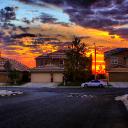Yahoo Answers is shutting down on May 4th, 2021 (Eastern Time) and the Yahoo Answers website is now in read-only mode. There will be no changes to other Yahoo properties or services, or your Yahoo account. You can find more information about the Yahoo Answers shutdown and how to download your data on this help page.
Trending News
i want to take a picture of the city, i am using 100iso film and at f11, how long should my exposure be?
what should be my range of times
the more accurate the better because im using film and i cant really check if i had exposed it long enough
i dont think 1/250 is a good start because ive had it on bulb and exposed it for 30 sec and it was too little
6 Answers
- ?Lv 79 years agoFavorite Answer
I use and recommend this site for low-light exposures: http://www.calculator.org/exposure.aspx
I chose the Scene 'Distant view of city skyline or floodlit buildings' and ISO 200 film for these:
http://www.flickr.com/photos/drifter45h/4048051455... 100mm lens @ f11, exposure of 30 seconds.
http://www.flickr.com/photos/drifter45h/4048796836... 200mm lens @ f11, exposure of 30 seconds.
Since you're using ISO 100 film try a 60 second exposure or open up to f8. I'd suggest using f8 and 30 seconds.
- jeannieLv 79 years ago
I've used times as long as 12 minutes to take images of the lit skyline of San Francisco from the roof of my building, using 100 speed film at a high aperture (32 or 64, 4x5 view camera). As Fred said, reciprocity failure occurs in long exposures and you have to compensate for the film "slowing down". You can use time rather than aperture if you aren't worried about the wind blowing foliage. Most other movement becomes a light blur (cars), people moving through the frame disappear entirely. Remember if you change aperture you have changed the depth of field.
Here is a link to a site with the reciprocity adjustments for some Kodak films:
http://www.seeinglight.com/reciprocity.shtml
here's a better one which has quite a few more types of film:
http://www.filmwasters.com/forum/index.php?topic=5...
You would do best to use a hand held light meter with a spot attachment and make sure to meter the shadows. Otherwise set your camera to spot metering (if you can) and be sure to meter the shadows, not the bright lights. You may also want to compensate in the development by underdeveloping the film by 10% time or so.
- Anonymous9 years ago
You appear to have missed out the important fact that you are looking to take NIGHT scenes - as that has only been advised by your response to the answers.
This has an important bearing on the answer because (a) you will need to give a lot more light than your indicated exposure (b) night time scenes involve the "Laws of Reciprocity" in which aperture / shutter speed combinations are not incremental.
Most photographers accept that night time photography is a matter of trial and error; using film means that you need to bracket your exposures to give the widest possible selection of aperture / exposure times. You suggest that 30 seconds at f11 is still too dark therefore you need to increase the aperture because - as far as I know the 30 seconds is as long as light is effective due to the consequences of reciptocity (I am open to the experience of others re this facet). This means taking 30 second exposures at f8 / f5.6 / f4 / f2.8 which effectively doubles the amount of light for each stop you increment.
I presume your film is processed by a film lab; once your next set of images are sent away for processing include a note explaining what you are seeking to achieve and ask them to offer guidance in the light of the results from the processed film
- LineDancerLv 79 years ago
Put your camera on aperture priority. It will determine the correct shutter speed for the lens opening you select.



